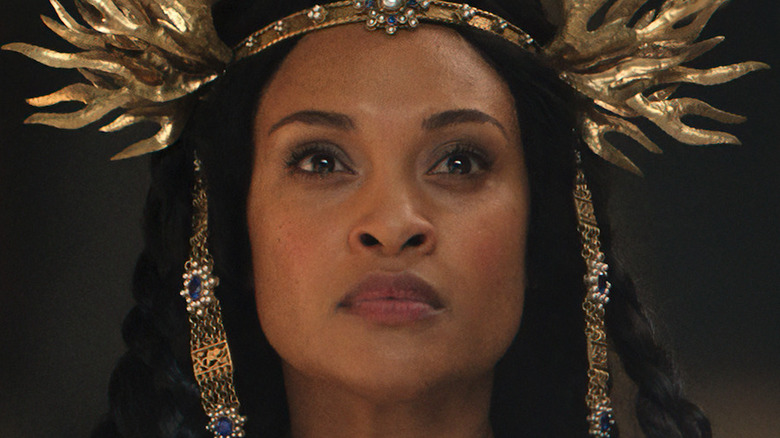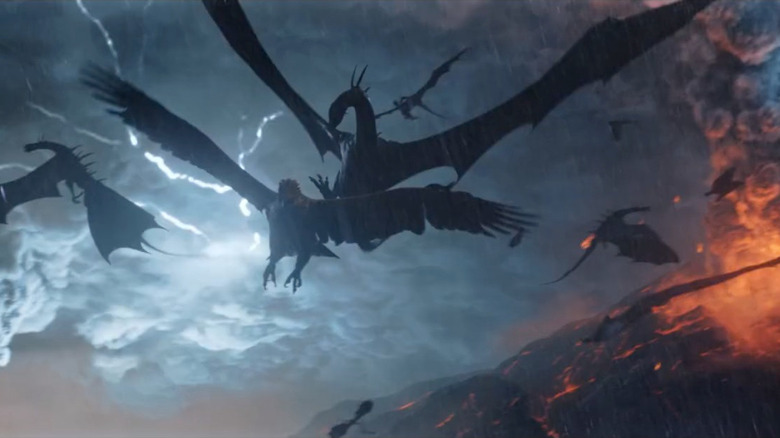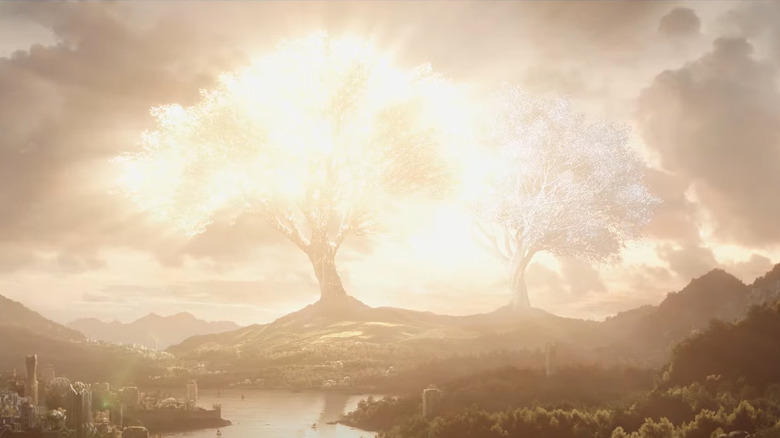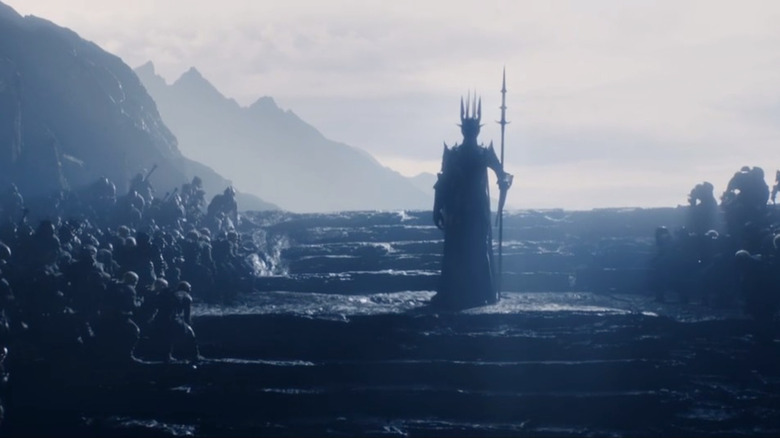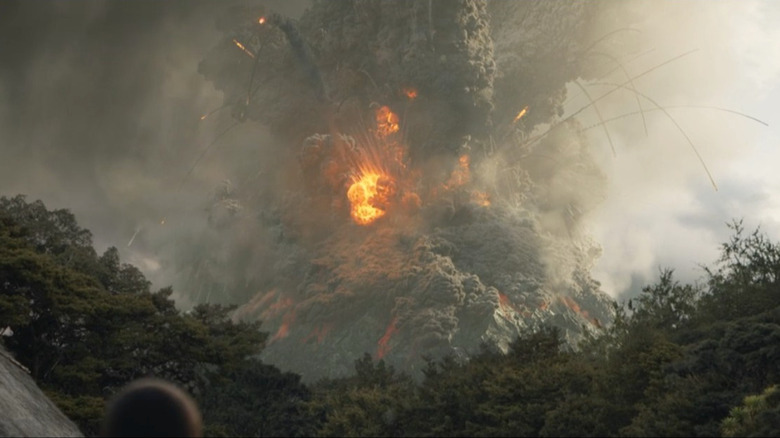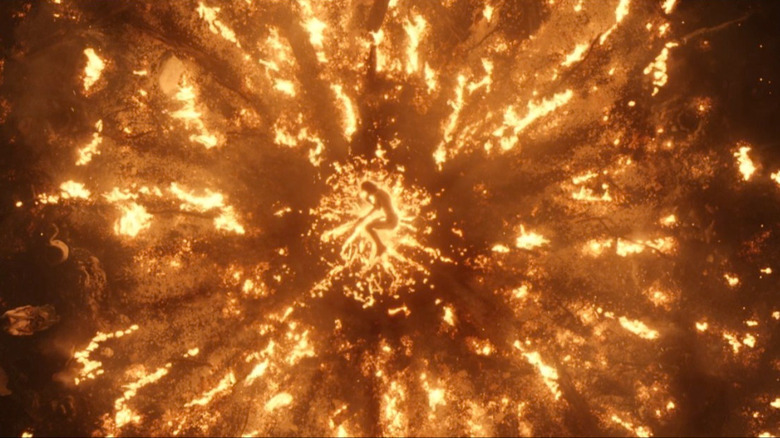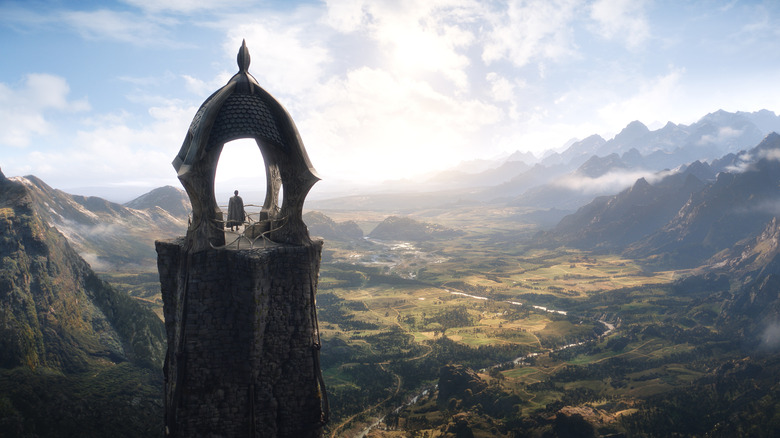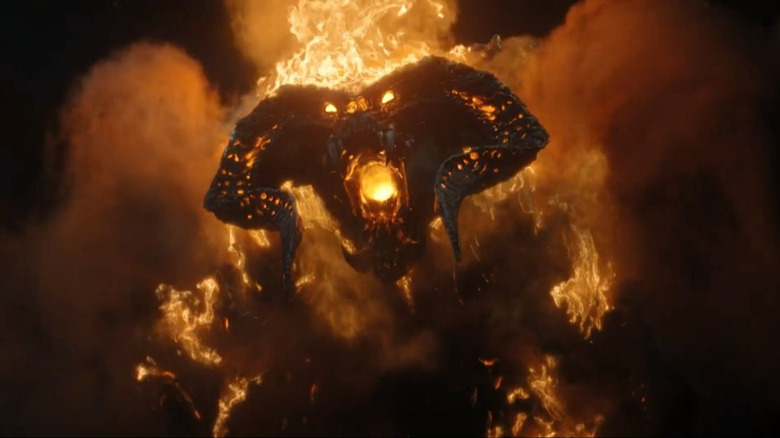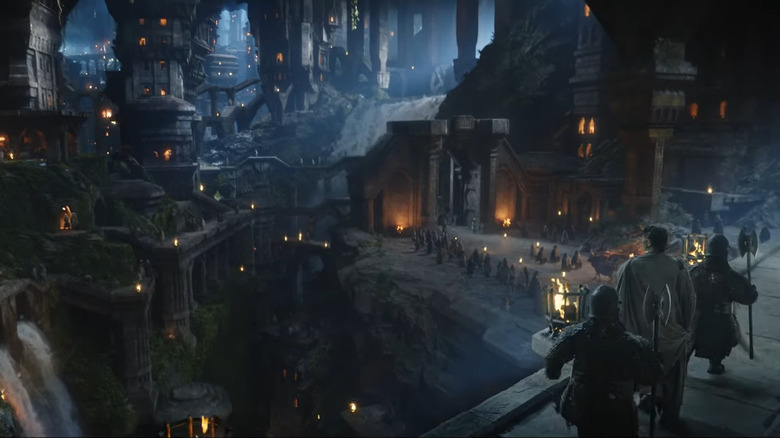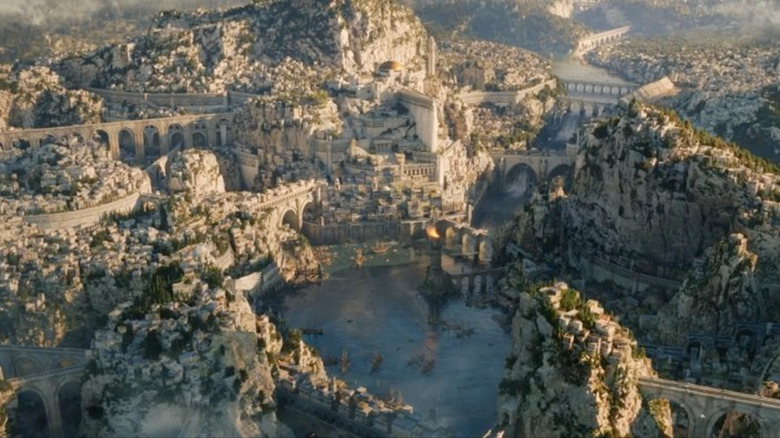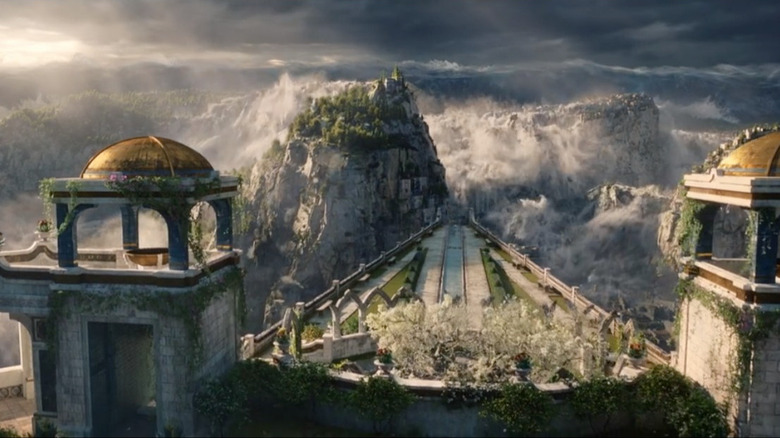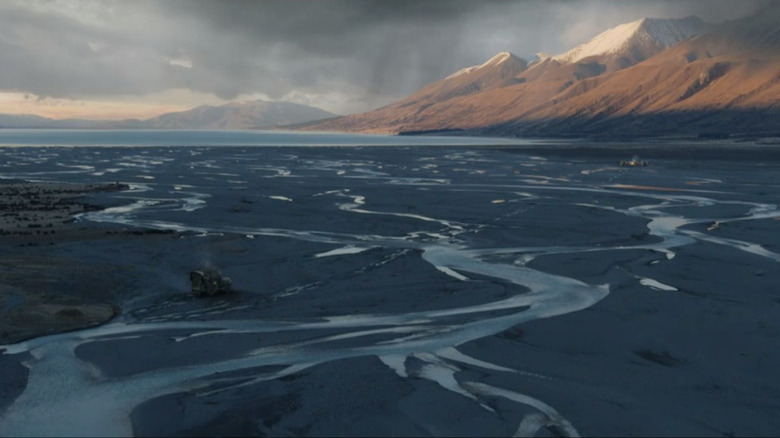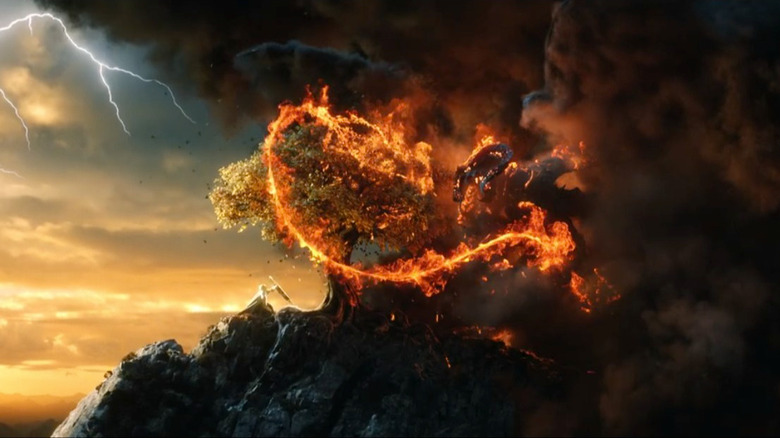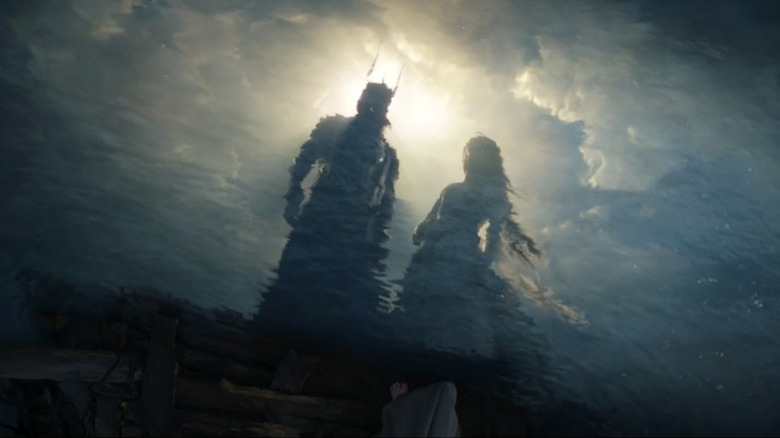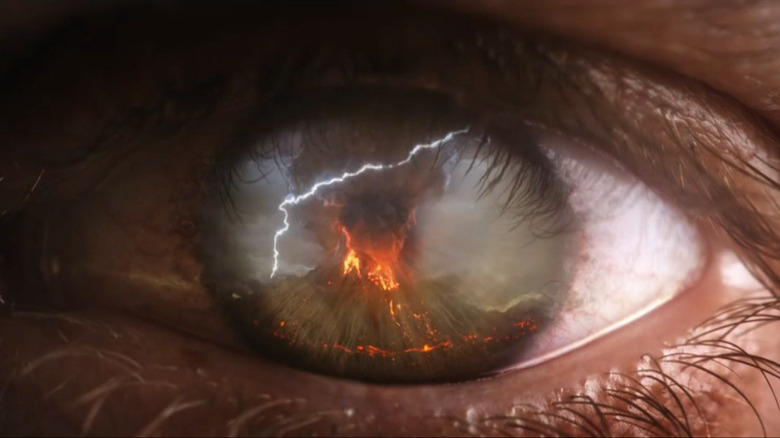The Most Pause-Worthy Moments In The Lord Of The Rings: The Rings Of Power Season 1
"The Lord of the Rings: The Rings of Power" introduces a lot of new characters and places during its first season, all set in the Second Age, thousands of years before the stories of "The Hobbit" and "The Lord of the Rings" take place.
A lot of the first season is spent establishing who's who and setting up storylines for the enormous five-season Middle-earth story arc that Amazon Prime intends to tell. This leads to some interesting pacing and plenty of legitimate criticism — something that is to be expected with the first season of any show.
One thing that the show does hit out of the park from day one, though, is the visual elements. From stunning sets to sweeping panoramas (hello, New Zealand), the first season of "The Rings of Power" is dripping with cinematic grandeur. Some of these eye-candy moments are connected to key points in the plot. Others are simply beautiful visuals worth every penny of the show's enormous budget. Many of these shots are so incredible they regularly have viewers scrambling for their remotes to hit the pause button. Here are a few of the most pause-worthy moments throughout the entire first season of the show.
The battle in the prologue
This one lumps three or four closely connected moments into one single montage of pause-worthy glory. Middle-earth is synonymous with epic battles, harrowing duels, and gigantic set pieces. These aren't consistently present throughout the eight hours of Season 1 of "The Rings of Power," but there's one spot, in particular, where we get a quick and mesmerizing overdose of Tolkien-themed violence: the prologue.
As the first minutes of the show play out, we're treated to a short, sweet, and vaguely recognizable rapid-fire sequence of events that, in effect, condense the major events of "The Silmarillion" into a digestible boilerplate format to set the stage for the show. Morfydd Clark's Galadriel narrates, and in the span of about two minutes, we get several of the wildest scenes in the entire inaugural season.
A few of these focus on a giant battle where we see Eagles fighting dragon-like creatures above swarms of Elves and Orcs duking it out on the battlefield. These are quickly followed by equally fascinating shots of burned cities half-submerged in the water and filled with the floating bodies of the slain. We even get a beautifully disturbing visual of Galadriel in pure white amidst the carnage of war, holding her brother's helmet and putting it onto a giant pile of other helms. For about two minutes there, no matter where you hit the pause button, there's something on the screen worth taking a closer look at.
The Two Trees of Valinor
The jam-packed prologue to the show gives us a lot more than exposition on the horrors of Middle-earth battle and war. They also come with some positive, encouraging, and light-filled stuff, too. No, seriously — there's literally a light-filled visual in the form of the Two Trees of Valinor.
These mighty arboreal edifices play a central role in the earliest stages of Tolkien's Middle-earth tales. When the world is first created, it's lit up by two giant pillars with lamps on top. When the Dark Lord Morgoth (Sauron's original master) destroys these, the Two Trees take their place. These are called Telperion and Laurelin. Telperion is a silver tree that mirrors the function of the moon; in fact, it creates that heavenly body later on in the Middle-earth mythos. Not surprisingly, Laurelin is a golden tree, and it creates the sun, too.
You'd think the powers that be would prevent Morgoth from breaking the light of the world two times in a row, but alas, that kind of wisdom is at a premium in mythological storytelling. The Dark Lord eventually shows up again with a nasty arachnid demon called Ungoliant by his side, and the pair of villains trash the Two Trees, sparking the series of events that lead to the First Age of Middle-earth history. The Two Trees are famous amongst diehard Tolkienites, but they haven't been seen onscreen until now.
The Sauron reveal
No, we're not talking about that Sauron reveal. Yes, the entire first season revolves around the "who's Sauron?" question. And when it's finally revealed to be (spoiler alert!) the King of the Southlands, it sets the stage for some fun storytelling to follow. But there's another Sauron reveal that we get much earlier in the season — less than ten minutes into the show, to be precise. As the prologue wraps up and we prepare to shift into the present, we get a panning shot across a large gathering of Orcs. In the background, Galadriel can be heard saying, "In the end, Morgoth would be defeated. But not before much sorrow. For his Orcs had spread to every corner of Middle-earth multiplying ever greater under the command of his most devoted servant, a cruel and cunning sorcerer. They called him Sauron."
The line ends with a shot of the future Dark Lord of Mordor himself, facing his armies of Orcs, larger than life, cloaked in long black robes, wielding a nasty spear, and wearing a tall, spiked crown. It's as awe-inspiring as it is spine-chilling and nothing like the feisty yet downtrodden Halbrand (Charlie Vickers) that we meet later on. It's a scene that has doubtless led to many a paused screen as fans take in the antagonist in all his otherworldly glory.
The eruption of Mount Doom
"The Rings of Power" is filled with mesmerizing visuals, but there are some that stand out even in that crowded playing field. The most obvious of these has to be the eruption of Mount Doom and the creation of Mordor. The event is hinted at throughout the first two-thirds of the season. At one point, it's revealed that the Southlands are in the area that is eventually known as Mordor. Arondir (Ismael Cruz Córdova) is captured by Orcs that are digging some kind of trench for unknown purposes. Adar (Joseph Mawle) is hellbent on finding Theo's (Tyroe Muhafidin) sword hilt even though it clearly doesn't function as a practical weapon of war anymore.
And then, at the end of Episode 6, everything comes together. Adar sends his Southlander lackey Waldreg to use his ancestral connection to the sword hilt to unlock a river. This races down the freshly dug Orcish waterway until it pours into the base of Orodruin, a deceptively quiet mountain that has been hovering in the background of the Southern story throughout the season. The reaction sparks the mountain's inner fury, unleashing a volcanic explosion that buries the surrounding region in fiery, ashen debris. While the hellscape is visually jaw-dropping after the fact, the explosion itself is a disturbing study of wonder — and well worth pausing on every watch.
The Stranger in the crater
The entire Stranger (Daniel Weyman) subplot of Season 1 is equal parts interesting and frustrating. After revealing little hints about his supernatural identity throughout the season, the "big reveal" in the finale merely confirms that he isn't Sauron and is, instead, one of the Istar or uppercase "W" Wizards, an elite group of individuals in Tolkien's world.
The Stranger's story ends with many more question marks than it started with (which is saying something), and while it will be fun to see where it goes in the future, the truly pause-worthy moment in his mysterious Season 1 storyline takes place not at its ending but at its genesis. After streaking across the Middle-earth heavens as a fireball at the end of the first episode, the meteor man crash lands in a fiery crater, where the Harfoots, Nori (Markella Kavenagh) and Poppy (Megan Richards), find the unexpected visitor surrounded by flames that don't consume him.
The entire crater scene was a challenge for the creative team to film, especially with the interactions between the Little People and the giant Wizard. But they were well worth the effort. The visual elements are fantastic. This is especially true for the closing shot of Episode 1, which reveals the Wizard lying in the fetal position in the middle of the crater surrounded by fire that very much so has an "Eye of Sauron" kind of vibe — a subtle hint that had countless viewers hitting pause, especially on that first watch.
Surveying the Southlands
Sometimes a scene is so beautiful or expansive — or both — that it creates the need to hit pause and just take everything in for a minute. The first time we get a view from the Watchtower of Ostirith in Episode 1, it screams "stop" on every level.
The view comes after we meet Arondir in the town of Tirharad. After checking in on the locals (including one Bronwyn), the Elven warden heads back to his post, a tall tower nestled into the mountains overlooking future Mordor. At this point, though, we're not getting a view of the Land of Shadow. The area is lush and filled with a soon-to-be-extinguished vibrancy.
The fertile landscape is unveiled in all of its visual glory when Arondir heads to the top of the tower, accompanied by his fellow warden Revion (Simon Merrells). As the pair of Elves talk, they gaze out over the landscape, giving us one of the best panoramic shots of the entire series. If only it could last. But alas, once we see it, the view is not long for this world.
The Balrog awakens
The Balrog of Moria is one of the most memorable villains in all of fantasy. Fans of the cinematic Middle-earth experience are familiar with the demon from its epic duel with Gandalf in Peter Jackson's "The Fellowship of the Ring." Now they have two visuals to point to whenever the fiery antagonist is brought up in conversation, thanks to Durin III's (Peter Mullan) symbolic leaf-tossing antics.
In Episode 7, the Dwarven king discovers Elrond (Robert Aramayo) and Prince Durin IV (Owain Arthur) burrowing through an unstable mine in pursuit of mithril. While the pair are successful, they're caught by the king before they can do anything about it. The embittered monarch goes back at the end of the episode and orders his servants to block up the mine. Before that happens, though, he symbolically tosses a golden leaf from Lindon through the opening as if to wash his hands of that Elvish nonsense.
The leaf floats far down through the chasm on the other side of the rock until it lands and immediately burns up. Why? Because it's right next to a Balrog — a Balrog that doesn't like the umbrageous disturbance. The beast unfurls its wings, self-ignites, and bellows into the darkness. The scene quickly cuts, creating the need to hit pause if viewers want a closer look. It's a well-warranted desire, too, as the Balrog bears a remarkable similarity to Peter Jackson's monster from two decades ago.
Visiting Khazad-dûm for the first time
In "The Lord of the Rings," the Fellowship of the Ring passes through Khazad-dûm on its way to Mordor. In "The Hobbit" movies, we also get a brief flashback of the battle of Azanulbizar, which is fought between the Orcs and the Dwarves right in front of the gates of — you guessed it — Khazad-dûm. In both of these cases, though, the subterranean kingdom isn't called Khazad-dûm anymore. It's referred to as "Moria," which translates from Elvish as "The Black Pit." This is, of course, because by that point in Middle-earth history, the Dwarven mansion has been smashed to bits by an angry Balrog who has taken up residence in the wreckage with an army of Orcs at its beck and call.
Earlier in its history, though, Khazad-dûm is a glorious place to behold. It's the greatest of all of the Dwarven kingdoms in Tolkien's writings, and by the Second Age, when "The Rings of Power" is set, it's at the peak of its glory.
The creative team behind the scenes was clearly aware of this fact, too, as they've invested a lot into giving Khazad-dûm a splendid, thriving, and even opulent appearance. Nowhere is this more obvious than when Elrond returns in the second episode. The visuals as the Elf ambassador walks across the bridge are incredible, and they truly depict a Dwarven culture at the height of its power and prowess.
Arriving at Númenor
"The Rings of Power" is a show with no shortage of thriving kingdoms to show off. The Elves have Lindon and Eregion, where Gil-galad and Celebrimbor rule, respectively. The Dwarves have their prosperous oversized mansion of Khazad-dûm. And Men? They have Númenor.
The island nation of Númenor has a rich and blessed history. The landmass is literally raised out of the ocean and given to its inhabitants as a gift. The Men who migrate there live undisturbed for centuries, and during that time, they blossom into a super-kingdom that is uniquely unrivaled in all of Tolkien's writings.
With centuries at their disposal, the Númenóreans invest a lot of time into building an architecturally stunning kingdom. In Tolkien's original writings, this includes multiple major cities across the island. In "The Rings of Power," most of the construction is condensed into the single, massive Númenórean capital city. When Galadriel and Halbrand arrive at this urban center on Elendil's (Lloyd Owen) ship, they look at the scene with well-warranted wonder. While fans can't have the same immersive experience as the in-story characters, they can at least hit pause and take in the visuals for as long as they'd like.
The destruction of Númenor
Númenor captures pause-worthy moments both coming and going. Galadriel and Halbrand's arrival at the capital city of the powerful nation of Men is awe-inspiring in all of its splendiferous glory. But the first scene of Episode 4 is also a Númenórean pause-worthy candidate for completely different reasons. In fact, it's worth pausing because we're literally seeing an image of the end of the island nation itself.
The episode opens with a vision from Queen Regent Míriel, who sees her ceremony honoring newborn children interrupted by a great tidal wave that crashes over the island, destroying buildings and sweeping everything away in its watery intensity. While it's just a vision, those familiar with the source material know that there's more to come. In the meantime, the visual elements of the vision alone are well worth pausing over and over again, leaving one to wonder how incredible it will look if and when the real thing happens in future seasons.
The wandering Harfoots
Fans of Tolkien know that not all who wander are lost, and when it comes to the Harfoots, the endless treks and wearisome roving are never by accident. On the contrary, the nomadic tribe of Halflings deliberately moves around from one season to the next, living off the land and avoiding perils at every turn.
This mobile lifestyle treats us to some nice visuals over the course of the season, with one particularly pause-worthy montage coming early in Episode 5 as the caravan of Harfoots heads toward greener pastures at their old camping spot called the Grove. The sequence is filled with one panoramic shot after another, showing gorgeous greenery, imposing mountains, and some really cool slick-looking flatlands. The Harfoot way of life doesn't lend itself to too many epic or pause-worthy moments. Sure, the Stranger adds some visual pizzazz to things, but overall they tend to avoid the limelight. When it comes to tracking them as they travel from point A to point B, though, the reasons to pause are a'plenty.
Mithril's origin story
One of the biggest deviations from the source material that the first season of "The Rings of Power" makes is the amplification of mithril from a really cool, extremely precious metal to a substance that the Elves need for their very survival. The twist on the miracle ore's importance has drawn skepticism from the Tolkien fanbase, and it's an issue that goes right back to the origin story of the metal itself.
In Episode 5, Elrond shares an apocryphal story about a pure Elf and an evil Balrog who fight over a silmaril in a tree located high up in the Misty Mountains. Lightening strikes the tree, supposedly creating mithril in the process. It's a deviation from Tolkien's writings that puts a new and unexpected pressure on the fading Elves throughout the first season of the show.
While the story is very un-Tolkienian, it admittedly gives us some of the coolest visuals of the entire series. The picture of the demon of Morgoth, surrounded by black clouds and wielding a fiery whip, as opposed to the clean, well-lit image of the Elf on either side of the tree is stunning, to say the least.
Sauron and Galadriel's reflection in the ocean
When Halbrand reveals himself to be Sauron in the season finale, he takes the betrayed Galadriel on a trippy vision to a couple of different points in her past. One of these takes the pair back to their life raft, adrift on the ocean, where they first met.
As they debate back and forth, Sauron tries to win the fiery Elven princess over to his side. At one point, he even suggests that they could have been king and queen together. The power play backfires and Galadriel fights her way out of the vision, but before that happens, the camera pans down into the water to show a warped reflection of the two characters in regal form. The thought of Sauron and Galadriel as partners in crime — and Middle-earth warlords, no less — is mind-blowing, and the terrifying visual suggestion is perfect fodder for a pause.
Mount Doom reflected in Sauron's cat-like eyeball
As the series ends, the last thing we see is Halbrand (now Sauron) walking into the Land of Shadow (consequentially disproving Boromir's future claim that "one does not simply walk into Mordor"). Doubtless, the Dark Lord has revenge on Adar and general conquest on his mind, and the scene starts with a close-up shot of Sauron lustfully gazing at Mount Doom. The fiery mountain is reflected in his eyeball, and at the last second, a dark slit can be seen forming in its pupil. That last detail harkens back to the source material, where the "eye of Sauron" is compared to a cat's dark, slitted peepers.
The scene is ominous, and it hints at much darker things to come. Its hidden, cat-like detail also makes it a great candidate for repeated pauses as fans take in the newly revealed Dark Lord in all his villainous glory. And then there's the simple fact that the reflected volcano in the eye is a really cool shot in and of itself.
